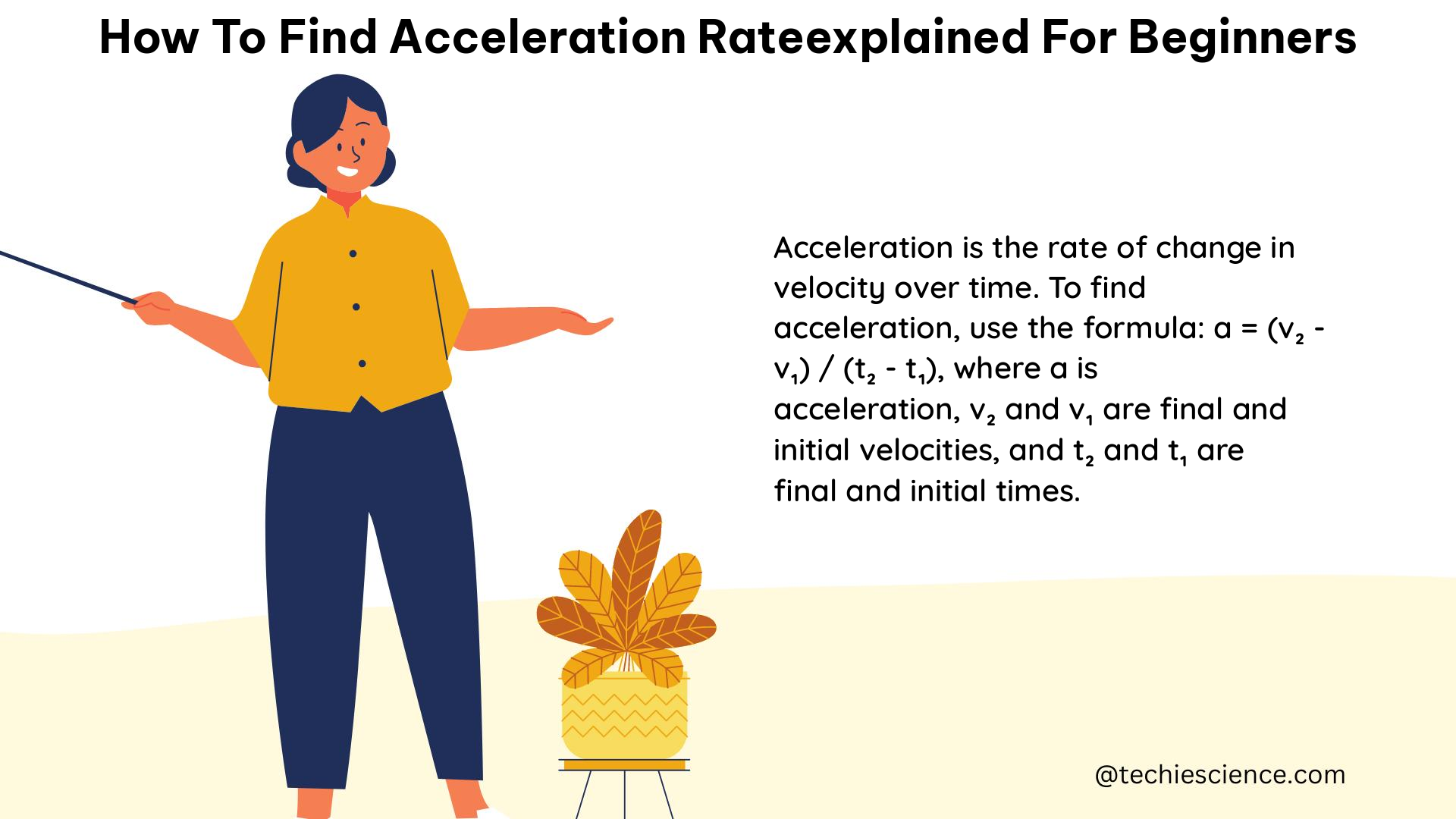Summary
Acceleration is a fundamental concept in physics that describes the rate of change in an object’s velocity over time. This comprehensive guide will walk you through the step-by-step process of calculating acceleration rate, providing you with the necessary formulas, examples, and practical applications to help you master this essential skill.
Understanding Acceleration

Acceleration is the change in an object’s velocity divided by the change in time. The formula for calculating acceleration is:
a = Δv / Δt
Where:
– a is the acceleration
– Δv is the change in velocity
– Δt is the change in time
The units for acceleration are typically meters per second squared (m/s²).
Calculating Acceleration: Step-by-Step
-
Identify the Initial and Final Velocities: Determine the object’s initial velocity (
v_i) and final velocity (v_f). -
Determine the Time Interval: Find the time interval (
Δt) over which the change in velocity occurred. -
Apply the Acceleration Formula: Plug the values of initial velocity, final velocity, and time interval into the acceleration formula:
a = (v_f - v_i) / Δt
- Solve for Acceleration: Perform the calculation to find the acceleration value.
Examples of Calculating Acceleration
Let’s explore some practical examples to solidify your understanding of calculating acceleration.
Example 1: Acceleration of a Car
Suppose a car is initially moving at a velocity of 15 m/s and accelerates to a velocity of 35 m/s over a period of 3 seconds.
To find the acceleration:
1. Initial velocity (v_i) = 15 m/s
2. Final velocity (v_f) = 35 m/s
3. Time interval (Δt) = 3 s
4. Plug the values into the acceleration formula:
a = (v_f - v_i) / Δt
a = (35 m/s - 15 m/s) / 3 s
a = 20 m/s / 3 s
a = 6.67 m/s²
Therefore, the acceleration of the car is 6.67 m/s².
Example 2: Acceleration of a Skydiver
Suppose a skydiver jumps out of a plane and reaches a terminal velocity of 50 m/s after 10 seconds.
To find the acceleration:
1. Initial velocity (v_i) = 0 m/s (assuming the skydiver starts from rest)
2. Final velocity (v_f) = 50 m/s
3. Time interval (Δt) = 10 s
4. Plug the values into the acceleration formula:
a = (v_f - v_i) / Δt
a = (50 m/s - 0 m/s) / 10 s
a = 50 m/s / 10 s
a = 5 m/s²
Therefore, the acceleration of the skydiver is 5 m/s².
Additional Kinematic Equations
In addition to the basic acceleration formula, there are other kinematic equations that can be used to find acceleration in different scenarios:
v_f = v_i + atd = v_i t + (1/2)at^2v_f^2 = v_i^2 + 2ad
Where:
– v_f is the final velocity
– v_i is the initial velocity
– a is the acceleration
– d is the distance traveled
– t is the time
These equations can be rearranged and used to solve for acceleration when different variables are known.
Factors Affecting Acceleration
Several factors can influence the acceleration of an object, including:
- Mass: The greater the mass of an object, the more force is required to change its velocity, resulting in a lower acceleration.
- Applied Force: The amount of force applied to an object directly affects its acceleration. The greater the force, the greater the acceleration.
- Friction and Drag: Opposing forces, such as friction and air resistance, can reduce the acceleration of an object.
- Gravity: The acceleration due to gravity, known as the gravitational acceleration, is a constant value of approximately 9.8 m/s² on Earth’s surface.
Practical Applications of Acceleration
Understanding and calculating acceleration is crucial in various fields, including:
- Transportation: Calculating the acceleration of vehicles, such as cars, trains, and airplanes, is essential for designing efficient transportation systems and ensuring safe operation.
- Sports and Athletics: Analyzing the acceleration of athletes during various sports activities can help coaches and trainers optimize performance and develop effective training programs.
- Engineering: Acceleration is a key factor in the design and analysis of mechanical systems, such as elevators, cranes, and robotic systems.
- Physics Research: Acceleration is a fundamental concept in the study of motion and is used extensively in various branches of physics, including classical mechanics, relativity, and quantum mechanics.
Conclusion
Mastering the concept of acceleration is a crucial step in understanding the principles of physics and their practical applications. By following the step-by-step process outlined in this guide, you can confidently calculate acceleration rates and apply this knowledge to a wide range of real-world scenarios.
Remember, practice is key to developing a strong understanding of acceleration. Engage in various exercises, solve numerical problems, and explore the resources provided to deepen your knowledge and become proficient in this essential physics skill.
Reference:
- How to Calculate Acceleration: The 3 Formulas You Need
- Acceleration (a) is the change in velocity (Δv) over the change in time (Δt)
- How to Find Acceleration: Review and Examples | Albert Resources
- How to Calculate Acceleration – 3 Formulas You Must Know
- How to Calculate Acceleration – Dummies

The lambdageeks.com Core SME Team is a group of experienced subject matter experts from diverse scientific and technical fields including Physics, Chemistry, Technology,Electronics & Electrical Engineering, Automotive, Mechanical Engineering. Our team collaborates to create high-quality, well-researched articles on a wide range of science and technology topics for the lambdageeks.com website.
All Our Senior SME are having more than 7 Years of experience in the respective fields . They are either Working Industry Professionals or assocaited With different Universities. Refer Our Authors Page to get to know About our Core SMEs.